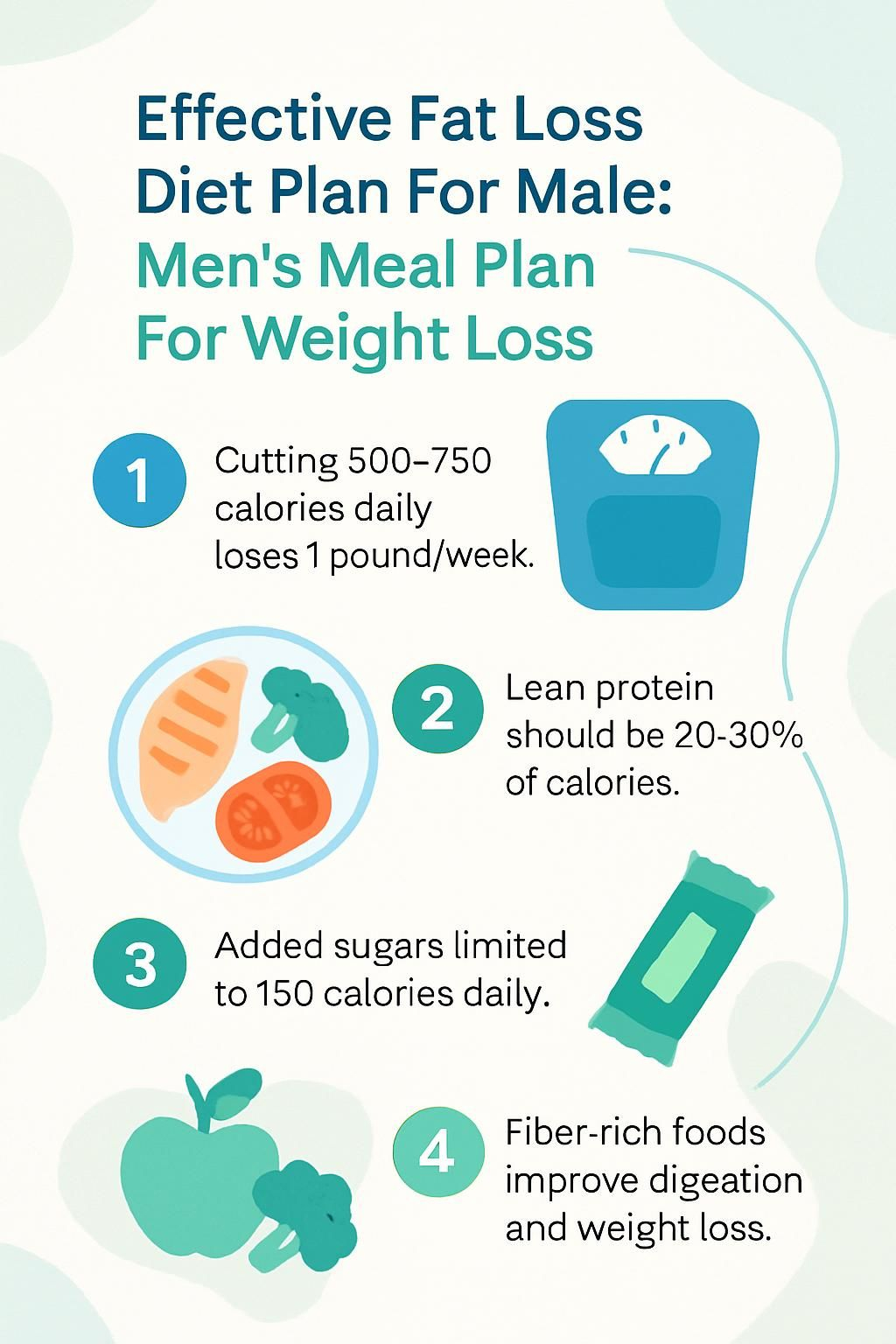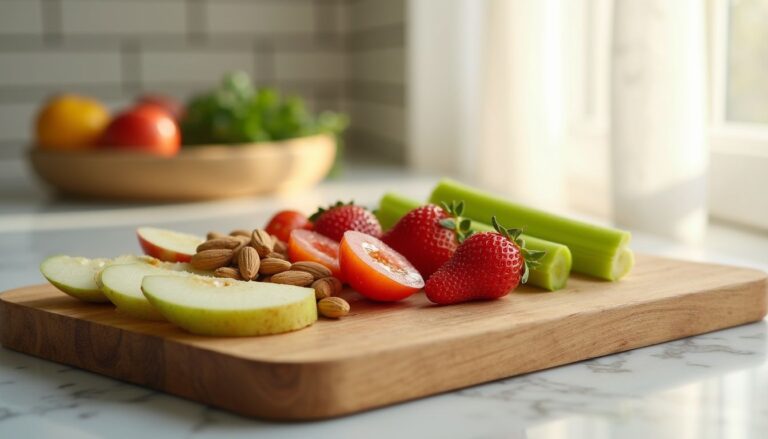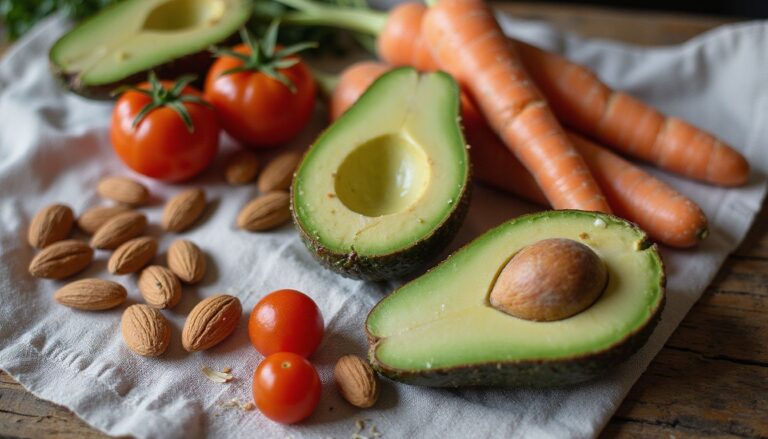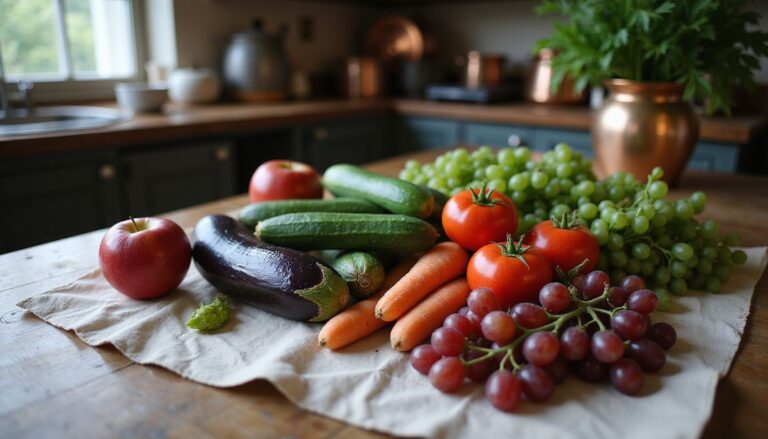Effective Fat Loss Diet Plan For Male: Men’s Meal Plan For Weight Loss
Our Nutrition Assistant AI Suite will transform your body. You will lose fat, get toned, and build muscle. Gain confidence and optimal health.
You want to lose weight, but sticking to a plan can feel tough. A clear weight loss diet plan gives structure, keeps you full, and protects your health. Research shows a smart plan can lower risk for heart disease and type 2 diabetes.
This guide breaks fat loss into simple steps. You will learn how to build a meal plan for men, pick foods that work, and use easy recipes you can repeat. Start today with small actions that you can keep for life.
Key Takeaways
- Most men can lose about 1 pound per week by cutting 500 to 750 calories daily, based on NIH Clinical Guidelines (U.S. Department of Health and Human Services).
- A balanced plan includes lean protein for 20 to 30 percent of calories, whole grains, plenty of vegetables, and healthy fats like olive oil or nuts.
- Limiting added sugar to under 150 calories per day supports heart health and better blood pressure.
- Higher fiber intake from fruits, vegetables, beans, and whole grains improves digestion and supports steady fat loss.
- Tracking meals with a food journal, like the Mayo Clinic Diet tools, helps consistency. Many people lose 6 to 10 pounds in the first two weeks when they follow a structured plan.

What Is Fat Loss and Why Is It Important?

Fat loss means you reduce stored body fat while keeping as much muscle as you can. This matters for your appearance, energy, and health. It also supports a healthy weight that you can maintain.
Losing extra weight lowers risk for type 2 diabetes, heart disease, high blood pressure, and sleep apnea. Men often see better mood, improved energy, and stronger confidence after starting a steady plan to lose weight.
Even a 5 to 10 percent drop in body weight can improve blood pressure and cholesterol.^[1] It can also lower triglycerides, which cuts the risk of heart attack or stroke.
A plan rich in vegetables and fruits plus regular exercise builds habits that last. No single strategy works for everyone. Results depend on food choices, calorie intake, physical activity, age, genetics, and your starting point.
Consistent action, both with nutrition and daily movement, is the path to sustainable fat loss.
^[1]: National Institutes of Health (NIH), “Clinical Guidelines on the Identification Evaluation and Treatment of Overweight and Obesity in Adults,” Department of Health & Human Services.
Key Principles of a Fat Loss Diet Plan for Men
These core ideas help you build a healthy eating plan that matches your weight loss goals.
How Do You Create a Calorie Deficit?
A calorie deficit means you eat fewer calories than you burn. Cutting 500 to 750 calories per day usually leads to about 1 pound of weight loss per week.
Start by trimming high-calorie, low-nutrient items. Limit sugary drinks, beer, candies, and rich desserts. Use the Dietary Guidelines for Americans for portion ideas and food group balance.
Increase movement to burn more calories. Mix strength training with cardio. Both raise your metabolism, which helps fat loss over time.
Before big diet changes or a weight-loss program, talk to your doctor. They can help set safe targets based on your age, health, BMI, and activity level.
What Are Nutrient-Dense Foods and Why Prioritize Them?
Nutrient-dense foods give you many vitamins, minerals, and fiber for fewer calories. This helps you feel full while staying in a calorie deficit.
Follow the Mayo Clinic Healthy Weight Pyramid. Fill most of your plate with vegetables and fruits. Add whole grains like oats, brown rice, and quinoa for steady energy. Choose lean meats, fish such as salmon, tofu, beans, nuts, and seeds. Limit ultra-processed foods that pack additives and added sugar.
I swapped packaged snacks for fresh produce. I could eat larger portions for fewer calories, and it made fat loss easier.
Choose real food more often than processed food if you want results that last.
Plant-forward eating patterns can lower risk factors for heart disease and type 2 diabetes. Reading labels helps you avoid products with hidden sugars and refined oils that slow your progress.
How to Balance Protein, Carbs, and Fats for Fat Loss?
Aim for protein to make up 20 to 30 percent of daily calories. Include a lean protein source at each meal, such as chicken, fish, Greek yogurt, or eggs.
Make at least half of your grains whole grains. Pick brown rice, quinoa, oats, or whole wheat bread instead of refined white bread or pastries.
Include healthy fats like olive oil, nuts, seeds, avocados, and fatty fish. Limit saturated fats from fatty cuts of red meat and butter. Avoid trans fat found in many fried and packaged snacks.
Swapping refined carbs for whole grains can improve BMI and lower type 2 diabetes risk. A daily meal plan with balanced macros supports even energy and better appetite control.
Why Is Consistent Meal Timing Important?
Eating at similar times each day helps control hunger. This supports portion control and lowers the chance of overeating. Spacing meals and snacks across the day keeps energy steady and reduces cravings.
Skipping meals, or big calorie cuts, can slow metabolism and trigger later overeating. Consistent timing also improves food choices because you are not overly hungry.
Using smaller plates and mindful eating works well with set meal times. This structure matches public health advice to spread your calories across breakfast, lunch, dinner, and snacks.
Nutritional Components of a Fat Loss Diet Plan
Your plan to lose fat depends on smart food choices. These components support weight management and your health.
How Does Protein Help with Fat Loss?
Getting 20 to 30 percent of calories from protein helps you keep muscle while losing fat. Protein increases fullness, so you snack less and handle a calorie deficit more easily.
Studies in overweight and obese adults show higher protein intake supports greater fat loss than lower protein approaches. Good sources include lean beef, pork loin, skinless chicken, fatty fish such as salmon or trout, eggs, beans, peas, tofu, soy foods, nuts, and seeds.
Many men rely on red meat for protein. Adding more plant proteins like lentils or quinoa can aid digestion and heart health. Using a higher protein sample meal plan helped me keep weight off without feeling deprived.
What Are the Benefits of Healthy Fats?
Healthy fats from olive oil, canola oil, nuts, seeds, fatty fish, and avocados support heart health. These unsaturated fats can raise good cholesterol and reduce cardiovascular risk factors.
The NHS notes that these fats supply nutrients needed for brain function and cell growth. They also keep you full longer, which supports a calorie deficit.
Sample plans often include small amounts of olive oil or soft spreads rich in unsaturated fats. Limit saturated and trans fats to protect your heart while you pursue fat loss.
Why Choose Complex Carbohydrates?
Complex carbs from whole grains like oats, quinoa, brown rice, and whole wheat bread keep you full longer. They bring fiber, vitamins, and minerals that support the gut and help long-term weight control.
The Dietary Guidelines for Americans recommend at least half of your grains be whole grains. Large intakes of whole grains link to a lower BMI. Diets high in refined carbs often lead to weight gain.
Swap simple carbs such as white bread or sugary cereal with options like buckwheat or air-popped popcorn. Men should limit added sugars to about 9 teaspoons, or 150 calories, per day according to the American Heart Association.
Added sugars hide in juices, desserts, soft drinks, candy, breakfast cereal, sweet dressings, and many diet products. I had better morning energy after replacing white toast with oatmeal.
This small change curbed cravings before lunch and helped me stay in a calorie deficit.
Summary Table:
| Food Item | Fiber Content | Calorie Density | Key Nutrients |
|---|---|---|---|
| Brown Rice | High | Low to Moderate | B Vitamins |
| Whole Wheat Bread | High | Low | Iron |
| Quinoa | Very High | Moderate | Magnesium |
| Popcorn, air-popped | Good Source | Very Low | Fiber and Minerals |
These foods deliver steadier energy than refined grains and fad snacks that rely on palm oil or added sugar.
How Do Fiber-Rich Foods Improve Digestion?
Fiber helps your digestive system work smoothly. It adds bulk to stool and supports regular bowel movements. Expect minor gas or changes at first as your body adjusts.
Plant-based meals bring vitamins, minerals, antioxidants, and fiber together. In the POUNDS Lost Study, people who ate more fiber lost weight faster and stayed on track longer.
Fiber adds fullness for fewer calories, which supports steady fat loss. After moving from processed items to higher fiber meals, I had fewer snack cravings and felt better after eating.
Getting enough fiber also helps control blood sugar and may reduce fat absorption. That matters if you are concerned about diabetes or heart health. Physical activity adds to these benefits.
Steps to Build an Effective Fat Loss Meal Plan
A simple plan starts with your calorie target, then balanced meals, smart portions, and foods that support health. Use the steps below to build a routine you can repeat.
How to Calculate Your Daily Calorie Needs?
Consider your age, sex, height, weight, and daily activity. This gives an estimate of how many calories you burn each day. Men 19 to 50 with light activity need fewer calories than very active men or athletes.
The Mayo Clinic Diet shares a 1,200 calorie sample meal plan for context. Your needs may be higher or lower.
Experts agree that cutting about 500 to 750 calories per day can lead to about 1 pound of weekly weight loss. Base your meals on nutrient-dense foods like grilled salmon with asparagus or avocado toast with poached egg.
I used an online calculator to set my target. Entering my details gave me a clear daily number, and walking each day helped me stick to it.
How Should Calories Be Distributed Across Meals and Snacks?
Split your daily calories across breakfast, lunch, dinner, and a couple of snacks. That pattern supports stable energy for regular physical activity and steady fat loss.
A sample day could start with whole grain toast, baked beans, and reduced fat milk. Add a mid-morning snack, a balanced lunch, an afternoon snack, a simple dinner, and a light evening snack.
Keep sweets small, about 75 calories per day, as suggested in the Mayo Clinic Diet. Fill half your plate with vegetables to manage portions and calories.
This spread prevents calorie overload in one meal and cuts hunger between meals.
What Are Appropriate Portion Sizes to Avoid Overeating?
Once you plan your meal pattern, focus on portion control. Mindful eating reduces the risk of overeating, especially during busy or distracted times.
The Mayo Clinic Healthy Weight Pyramid offers serving sizes. Measure 65 grams of roast beef as one serving. Keep nuts to 30 grams per snack.
Smaller plates make it easier to stick to moderate servings. Choose about one cup of vegetables per serving and measure oils. The American Heart Association explains that a portion is what you choose to eat while a serving is listed on the label.
Weighing ingredients helped me a lot. Pouring only 14 grams of olive oil in the pan instead of guessing gave me better results on a lower carb plan.
Summary Table: Example Portion Sizes
| Food Item | Sample Portion |
|---|---|
| Roast Beef | 65 grams |
| Reduced Fat Cheese | 20 grams |
| Unsalted Nuts | 30 grams |
| Cooked Fish | 100 grams |
| Olive Oil | 14 grams, 1 tbsp |
| Reduced Fat Yogurt | 100 grams |
| Vegetables, broccoli | 1 cup cooked |
| Carrots | 1 cup cooked |
| Tomato | 1 medium |
| Potato | 1 medium |
| Diced Fruit Salad | 1 cup |
Managing portions keeps meals satisfying and controlled, which supports better blood pressure and healthier habits.
Sample Fat Loss Meal Plan for Men
Use these ideas to build a meal plan for men that fits your calorie goal and taste. Repeat your favorites to save time.
What Are High-Protein Breakfast Options?
High protein breakfasts improve fullness and support muscle while losing fat. Pair protein with whole grains and produce.
- Two slices whole grain toast with 2 teaspoons soft spread, 1 cup baked beans, and 1 medium tomato.
- One cup reduced fat milk to boost protein and minerals.
- Overnight oats with berries and sliced pear for fiber and protein, great for a 1,200 calorie day.
- Broccoli and feta omelet to add protein and vegetables early.
- Poached egg on whole grain avocado toast for protein and healthy fats.
- Greek yogurt with berries, or use it to make quick tzatziki for a savory option.
- Baked beans with a sprinkle of reduced fat cheese in a whole grain quesadilla.
- Cottage cheese or lean turkey slices with tomato on toast.
- Use water or reduced fat milk instead of juice in oatmeal or shakes to save calories.
These options support muscle, keep you full, and fit a practical diet plan for weight loss.
How to Build Balanced Lunches with Lean Protein and Vegetables?
Lunch should keep you steady through the afternoon. Build your plate with protein, fiber, and color.
- Choose lean protein like 65 grams of roast beef or a serving of reduced fat cheese.
- Use whole grain bread or grains for fiber and micronutrients.
- Add at least 1 cup mixed salad vegetables such as lettuce, tomato, cucumber, or spinach.
- Include healthy fats, such as up to 2 teaspoons of soft spread rich in unsaturated fats.
- Measure portions to avoid overeating during busy days.
- Pick nutrient-dense foods instead of heavily processed items high in sugar or sodium.
- Include many colors for a wider mix of vitamins and antioxidants.
- Try Tuscan white bean soup with a small pesto drizzle for a filling, lower calorie lunch.
- Keep your meal timing regular to avoid hunger spikes.
- Drink water before you eat to support digestion and reduce snacking later.
Batch cooking lean proteins on Sunday helped me build fast, balanced lunches that tasted great and kept me on track.
What Are Low-Carb, Nutrient-Packed Dinner Ideas?
Dinner should be satisfying without pushing calories too high. Focus on protein, vegetables, and healthy fats.
- Grilled fish with olive oil, 1 cup boiled rice, 1 medium potato, 1 cup carrots, and 1 cup broccoli.
- Sheet pan roast chicken with broccoli rabe, onion, and tomatoes for a simple 1,200 calorie day.
- Stir-fried chicken or turkey in olive oil with non-starchy vegetables like bell peppers.
- Broccoli and feta omelet for a light, high protein dinner.
- Grilled salmon with steamed asparagus for omega-3 fats and selenium.
- Poached egg over avocado toast on whole grain bread for a light dinner with fiber.
- Lean beef or tofu sautéed with spinach or kale for iron and volume from greens.
Pick two or three go-to dinners and rotate them to reduce decision fatigue.
Which Healthy, Low-Calorie Snacks Are Best?
Smart snacks help you maintain a calorie deficit and steady energy. Pair produce with protein or healthy fat.
- One medium apple with coffee and 200 ml milk, about 130 calories.
- Thirty grams of unsalted nuts with coffee and 200 ml milk in the afternoon.
- One cup fruit salad with 100 grams reduced fat yogurt in the evening.
- Sliced bell peppers, about 1 cup, with a banana for a colorful, under 120 calorie snack.
- Combine fruit or vegetables with dairy or nuts to avoid added sugar and stay full longer.
- Choose mineral-rich snacks like yogurt or nuts to support bone health and recovery.
Plan snacks with the same care as meals. That small step prevents impulse choices.
Easy-to-Prepare Fat Loss Recipes for Men
These quick recipes support your nutrition goals and keep prep simple on busy days.
How to Make Chicken and Vegetable Stir-Fried Rice?
Use 100 grams of cooked chicken breast, cubed. Heat 1 tablespoon olive oil in a large nonstick pan over medium heat. Add the chicken and cook until lightly browned.
Add mixed vegetables like carrots, bell peppers, and broccoli. Cook for about 3 minutes. Stir in 1 cup boiled rice and season with low sodium soy sauce or herbs.
I like the vegetables crisp. The texture is better, and more nutrients stay in the food.
What Is a Simple Broccoli and Feta Omelet Recipe?
Whisk two eggs. Heat a nonstick skillet over medium heat and mist with oil. Cook 1 cup chopped broccoli for about 3 minutes.
Pour eggs over broccoli and cook for 1 minute. Sprinkle 20 grams reduced fat feta. Fold the omelet and cook until set.
Serve hot. The mix of eggs and vegetables gives a high protein, low calorie meal that keeps you full.
How to Prepare Quick Berry Oatmeal?
Mix 1/2 cup oats with 1 cup reduced fat milk in a microwave-safe bowl. Stir in 1/2 cup mixed berries such as blueberries or strawberries.
Add half a pear for natural sweetness and extra fiber. Microwave on high for 2 minutes, stirring halfway. The result is creamy and filling, usually under 300 calories.
What Is a Healthy Grilled Salmon with Steamed Asparagus Recipe?
Pick a fresh 4 ounce salmon fillet. Brush with olive oil, season with lemon juice, pepper, and a pinch of salt. Grill 3 to 4 minutes per side on medium heat until it flakes with a fork.
Steam 1 cup asparagus for 3 to 4 minutes until crisp tender. Asparagus adds fiber and vitamins A, C, E, and K. This meal supplies at least 25 grams of protein and healthy fats that support a fat loss diet plan.
How to Make Poached Egg and Avocado Toast?
Toast one slice whole grain bread. Mash half an avocado on top for healthy fats. Poach one large egg in simmering water for about 3 minutes until the whites set.
Set the egg on the toast and season with pepper or chili flakes. One large egg offers about 6 to 7 grams of protein, which supports muscle during fat loss [1].
I use this on busy mornings. It satisfies me until lunch and fits my calorie target.
[1] U.S. Department of Agriculture (USDA) FoodData Central: One large egg contains around 6–7 g protein each; total content will vary by size.
Tips for Staying on Track with Your Diet Plan
Consistency beats intensity. These habits help you stick to your plan and see progress week after week.
How Can Meal Prepping Help You Stay Consistent?
Meal prep makes your daily choices easier. You plan ahead, so portions and calories are already set. Many men find this reduces last minute takeout and snacking.
The Mayo Clinic Diet offers digital tools such as a food journal, exercise log, and weight tracker. Those tools improve accountability and make it easier to spot trends.
During hectic weeks, prepped meals save time and limit decision fatigue. Packing several days of lunches at once kept me on track because my plan was clear.
Why Avoid Processed and Sugary Foods?
Ultra-processed foods often hide long ingredient lists and added sugars, salt, and unhealthy fats. Trials show they can raise calorie intake and speed weight gain.
Check labels to avoid sugary drinks, candies, desserts, beer, and many cereals. Men should cap added sugar at about 9 teaspoons, roughly 150 calories, per day.
I replaced a daily soft drink with water. After one week my cravings eased, and my waist dropped faster.
How Much Water Should You Drink Daily?
Poor hydration links to higher obesity risk. Drinking 8 ounces of water before meals can help you eat fewer calories and manage hunger.
Your needs vary with activity, age, and climate. A simple guide is to sip when thirsty and keep a bottle nearby. Many athletes track fluids with apps for consistency.
How Does Stress Affect Eating Habits and How to Manage It?
Stress can drive overeating and cravings for sugary, high calorie foods. Cortisol, a stress hormone, can raise appetite and push you toward quick comfort foods.
Use mind-body practices like yoga, breathing exercises, or meditation to ease stress and reduce emotional eating. Ten minutes a day is a good start. Calm choices lead to better meal choices.
How Does Exercise Support Fat Loss?
Exercise helps you burn calories, protect muscle, and improve mood while you lose fat.
Why Combine Strength Training with Cardio?
Strength work helps you keep muscle. Cardio raises your daily calorie burn. Studies show men who do both lose more belly fat than those who do only one type.
Target at least 150 minutes of moderate activity or 75 minutes of vigorous activity each week. Add two strength sessions for best results. I kept more weight off after adding lifting to my walking routine.
How to Incorporate Daily Physical Activity?
Short bursts count. Start with 5 to 10 minute bouts if you are new to exercise, then build up slowly.
Take the stairs, park farther away, or take quick walking breaks. Try resistance moves at home using bodyweight or bands. If you have joint pain, pick joint-friendly options like swimming or chair exercises.
Make your plan personal. You are more likely to stick with it and see steady fat reduction.
What Are Common Fat Loss Diet Mistakes to Avoid?
A few common errors can stall your results. Avoid these traps for smoother progress.
Why Should You Avoid Skipping Meals or Extreme Calorie Restriction?
Skipping meals or cutting calories too far can slow metabolism and lead to muscle loss. Very low calorie diets often cause fatigue, irritability, and rebound hunger.
The Mayo Clinic Diet favors steady change over drastic cuts. When I skipped breakfast, I felt tired and then overate at lunch.
Quick-fix plans rarely last. People often regain the weight within a year because the habits do not stick. Balanced nutrition is safer and more effective.
How Important Is Portion Control?
Portion control is vital for fat loss. Big plates and large restaurant servings can trick your eyes and lead to overeating.
Using smaller dishes can cut calorie intake by a large margin. The Mayo Clinic Healthy Weight Pyramid teaches portion awareness so you can eat enough without excess.
Switching to smaller plates helped me feel satisfied with less food while meeting my goals.
What Are the Risks of Over-Relying on Diet Trends or Supplements?
Fad diets can cause rapid water or muscle loss, not true fat loss. Many supplements lack strong evidence and some can raise blood pressure or strain the heart.
Chasing trends prevents you from building solid habits. Research supports long-term weight management through balanced meals and lifestyle changes, not a quick pill.
A coworker tried a crash diet and lost 10 pounds in two weeks, then felt weak and regained the weight. Slow and steady methods work better.
How to Monitor Progress and Adjust Your Fat Loss Plan?
Track what matters, then make small, careful changes when progress slows. That approach keeps you moving forward.
What Are Effective Ways to Track Weight Loss and Body Measurements?
Use a digital weight tracker and a food and exercise journal. Weigh at the same time each week, often in the morning after using the bathroom.
Measure waist, chest, hips, arms, and thighs every two weeks. Photos in the same outfit and light can show changes the scale misses. Writing down meals plus weekly weigh-ins kept me motivated even when pounds dropped slowly.
When and How Should You Adjust Calorie Intake?
If you lose 6 to 10 pounds in the first two weeks, you likely have an appropriate calorie deficit. After that, aim for 1 to 2 pounds per week.
If weight stalls for more than two weeks, reduce intake by 100 to 200 calories per day or add activity. I hit a plateau after losing several pounds. A small calorie cut restarted my progress without low energy.
Talk with a registered dietitian or your healthcare provider before major changes to your calorie target. Safety comes first.
Conclusion
A clear fat loss diet plan for men helps you make steady progress and protect your health. Focus on nutrient-dense foods, smart portions, and a realistic calorie target. Include lean protein, complex carbs, and healthy fats so meals are satisfying.
Simple tools like a food journal improve accountability. Many people see 6 to 10 pounds of loss in the first two weeks with a structured plan. Keep your steps small and consistent. Over time, those steps help you reach your weight goals and feel better day to day.
This article is for general education. For medical concerns or special diets, consult your doctor or a registered dietitian.
FAQs
1. What is an effective fat loss diet plan for men?
An effective fat loss diet plan for men focuses on reducing calorie intake, increasing protein consumption, and choosing nutrient-rich foods. Studies show that a daily deficit of 500 to 750 calories can help most adult males lose about one to two pounds per week. A sample meal plan may include lean meats, whole grains, vegetables, fruits, and healthy fats.
2. How much protein should men eat when following a weight loss meal plan?
Research suggests that consuming 0.7 to 1 gram of protein per pound of body weight helps preserve muscle during weight loss efforts. For example, a man weighing 180 pounds should aim for about 126 to 180 grams of protein each day from sources like poultry breast or fish fillet.
3. Can you provide an example of a men’s meal plan for weight loss?
A typical day might start with oatmeal topped with berries at breakfast; grilled chicken salad with mixed greens at lunch; Greek yogurt as a snack; salmon fillet with steamed broccoli and brown rice at dinner; and cottage cheese before bed. This approach balances macronutrients while keeping total calories in check.
4. Are there any personal tips for sticking to a fat loss diet as a male?
Tracking food intake using apps or journals increases awareness and accountability according to clinical studies published in peer-reviewed nutrition journals such as The American Journal of Clinical Nutrition (2019). In my own experience working toward fitness goals last year, planning meals ahead made it easier to avoid high-calorie temptations after work hours.
Summary: Effective fat loss diets for men rely on calorie control, higher protein intake, balanced meals featuring whole foods like vegetables and lean proteins, plus consistent tracking methods supported by research evidence.







